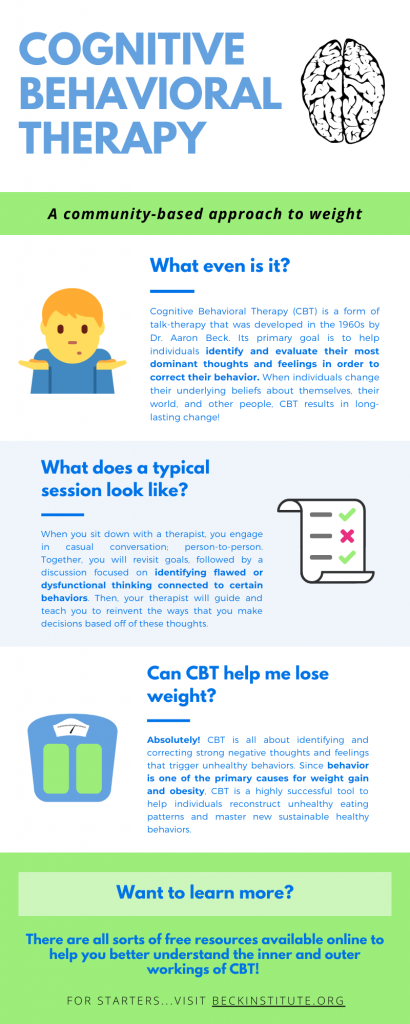14 Cognitive Behavioral Therapy
Brian Weaver
Major Determinants of Obesity
It’s no question; America is overeating. In fact, the Centers for Disease Control (CDC), reports that nearly 40% of American adults in 2016 were obese (Centers for Disease Control, 2016). In other words, two out of every five adults in the United States are living with a dangerous amount of excess body fat and it is affecting both their current and future health.
Research shows that there are a variety of factors that cause and increase the risk of obesity, including age, socioeconomic status, and other diseases such as heart disease or diabetes (Mayo Clinic Staff, 2011). However, there are two major determinants that stand out among the rest – genetics and behavior (Mayo Clinic Staff, 2011).
Treatment Approaches
Although science and modern medicine have opened the door to gene therapy, it is a new and extremely limited form of treatment for obesity. Behavior modification, however, is a proven form of treatment to help individuals create new, healthier lifestyle rhythms. While there are many different approaches to behavior modification, one, in particular, has been widely successful.
Cognitive Behavioral Therapy
“Pi Cognitive behavioral therapy,” from Emil Asgrimsson is licensed under CC BY-SA.
Cognitive behavioral therapy (CBT) is a psychotherapy that “focuses on how our thoughts, beliefs, and attitudes can affect our feelings and behavior (Harvard Health Blog, 2018).” At its most basic level, CBT helps individuals identify and evaluate their most dominant thoughts and feelings in order to correct their behavior.
Cognitive behavioral therapy was developed by Dr. Aaron T. Beck in the 1960s. Dr. Beck, a Yale Medical School trained psychiatrist, established the earliest version of CBT while analyzing the underlying factors and causes of depression (Beck Institute, 2019). During this process, he discovered something that would become foundational to CBT – “automatic thoughts”. Automatic thoughts are spontaneously occurring negative thoughts leading to emotional and behavioral responses (Beck Institute, 2019). Through the development of this concept, Dr. Beck concluded that “when patients changed their underlying beliefs about themselves, their world and other people, therapy resulted in a long-lasting change (Beck Institute, 2019).” Thus, Cognitive behavioral therapy was born!
CBT in Action

In psychotherapy, a conversation is central to treatment. Individuals begin the process of CBT by setting goals (Cully, 2008). They answer the question, “what is it that I want to do?” After this, each session generally consists of revisiting personal goals and having an “active discussion”. This type of conversation is central to CBT and it focuses on identifying the automatic thoughts, emotions, and feelings that come before a specific behavior.
Identifying dysfunctional thinking and distorted beliefs is a key component of CBT that is accomplished during each session (Beck, 2019). Once identified, therapists help individuals modify and reinvent their decision-making processes, eventually leading to the accomplishment of their goals. This process, shown to be successful in thousands of cases (Beck, 2019), can be applied to all sorts of different behaviors and disorders.
CBT + Obesity
Obesity research provides strong evidence that the most successful ways to effectively manage weight are “monitoring food intake and increasing physical activity” (Jacob et al., 2012). In other words, by focusing on two specific behaviors, an obese individual can successfully lose or maintain their weight.
When CBT is applied as a treatment for obesity, the fundamental idea of identifying and changing flawed thinking that leads to undesirable actions (i.e. overeating; lack of exercise) is crucial. Perhaps the oldest and largest cognitive therapy institution today, founded by Dr. Aaron Beck, is the Beck Institute. In their approach to CBT, they aim to keep the length of “in-house” therapy short and to train individuals to be their own therapist (Beck, 2019). Therefore, through time and proper practice, individuals will learn to independently wield CBT as a powerful tool that it is in multiple areas of their life.
Another way it is being successfully used to help people control their weight is through diet programs. Dr. Judith Beck, daughter of Dr. Aaron Beck, has authored several books that apply CBT specifically to dieting. Through these resources, individuals lose and control weight by being taught to “think differently and overcome common dieting pitfalls and sabotaging thoughts (Beck, 2016).”
CBT + Eating Disorders
Eating disorders are understood to largely be the result of distorted perceptions, attitudes, and feelings about oneself. In a study that investigated the extent to which CBT can help people “tackle” those feelings and behaviors, it found CBT to be a successful form of treatment, while also increasing the individual’s personal motivation to change (Wilfley et al., 2011).
In regard to one particular disorder, Binge Eating Disorder (BED), CBT is proven to be the “best established treatment” (Castelnuovo et al., 2017). BED is exactly what it sounds like – “recurrent binge-eating that occurs in the absence of regular compensatory behaviors” (Castelnuovo et al., 2017). In other words, people suffering from BED regularly eat excessive amounts of food while showing little to no control over their actions. Due to the nature of its casual, talk-therapy nature, cognitive therapy is a low-intensity, low-cost treatment option for Binge Eating Disorder that also has wide success in preventing long-term remission (Hilbert et al., 2015).
Summary
It’s clear; America is overeating and it is a national concern. Cognitive behavioral therapy is a proven solution that enables people to reconstruct unhealthy behavior patterns (see summary infographic below). Through effective training, practice, and social support, Americans can take control of their minds and live improved, healthier lives. It truly is the thought that counts!

Review Questions
1. What two factors are primarily responsible for obesity?
a. Stress and Genetics
b. Stress and Age
c. Genetics and Behavior
d. Socioeconomic Status and Age
e. Socioeconomic Status and Behavior
2. What did Dr. Aaron T. Beck observe that would later become foundational to cognitive behavioral therapy?
a. Active Thoughts
b. Negative Thoughts
c. Passive Thoughts
d. Automatic Thoughts
3. What is the primary goal of CBT?
a. Identify and evaluate one’s most dominant thoughts and feelings in order to correct their behavior
b. Minimize the length of “in-house” therapy and train individuals to be their own therapist
c. Identify “dysfunctional thinking” that prevents proper goal setting
d. Create realistic, attainable goals that lead to independent thinking
References
Beck Institute. (2016). About the Beck diet program. https://diet.beckinstitute.org/about-the-beck-diet-program/
Beck Institute. (2019). General faqs. https://beckinstitute.org/general-faqs/
Beck Institute. (2019). History of Cognitive behavior therapy. https://beckinstitute.org/about-beck/team/our-history/history-of-cognitive-therapy/
Beck Institute. (2019). What is Cognitive behavior therapy (CBT)? https://beckinstitute.org/get-informed/what-is-cognitive-therapy/
Castelnuovo G., Pietrabissa G., Manzoni G. M., Cattivelli R., Rossi A., Novelli M., et al. (2017). Cognitive behavioral therapy to aid weight loss in obese patients: current perspectives. Psychology Research and Behavior Management, 10, 165–173. https://doi.org/10.2147/PRBM.S113278
Centers for Disease Control. (2016, June 13). Faststats – overweight prevalence. https://www.cdc.gov/nchs/fastats/obesity-overweight.htm
Cully, J. A., & Teten, A.L. (2008). A therapist’s guide to brief cognitive behavioral therapy. Department of Veterans Affairs South Central MIRECC, Houston. https://www.mirecc.va.gov/visn16/docs/therapists_guide_to_brief_cbtmanual.pdf
Harvard Health Blog. (2018). Intensive CBT: How fast can I get better? https://www.health.harvard.edu/blog/intensive-cbt-how-fast-can-i-get-better-2018102315110
Hilbert, A., Hildebrandt, T., Agras, W. S., Wilfley, D. E., & Wilson, G. T. (2015). Rapid response in psychological treatments for binge eating disorder. Journal of Consulting and Clinical Psychology, 83(3), 649–654.
Jacob, J. J., & Isaac, R. (2012). Behavioral therapy for management of obesity. Indian Journal of Endocrinology and Metabolism, 16(1), 28–32. https://doi.org/10.4103/2230-8210.91180
Mayo Clinic Staff. (2011). Symptoms and causes. https://www.mayoclinic.org/diseases-conditions/obesity/symptoms-causes/syc-20375742?p=1
Wilfley, D. E., Kolko, R. P., & Kass, A. E. (2011). Cognitive-behavioral therapy for weight management and eating disorders in children and adolescents. Child and Adolescent Psychiatric Clinics of North America, 20(2), 271–285. https://doi.org/10.1016/j.chc.2011.01.002
agency of the Department of Health and Human Services responsible for the prevention and control of disease and for health promotion and education. The CDC was established in Atlanta as the Communicable Disease Center in 1946, charged with preventing the spread of malaria. Under its present name, the agency monitors the spread of all infectious diseases within the U.S. and provides assistance to other countries and agencies in disease prevention and control. It also provides expertise and assistance to other federal, state, local, and private disease prevention agencies. Additionally, it develops and conducts environmental health and general health promotion programs
An individual's or group's position within a hierarchical social structure. Socioeconomic status depends on a combination of variables, including occupation, education, income, wealth, and place of residence. Sociologists often use socioeconomic status as a means of predicting behavior.
https://www.dictionary.com/browse/socioeconomic-status?s=t
an element that identifies or determines the nature of something or that fixes or conditions an outcome
the insertion of usually genetically altered genes into cells especially to replace defective genes in the treatment of genetic disorders or to provide a specialized disease-fighting function
treatment of mental or emotional disorder or of related bodily ills by psychological means
spontaneously occurring negative thoughts leading to emotional and behavioral responses
Beck Institute. (2019). History of Cognitive behavior therapy. https://beckinstitute.org/about-beck/team/our-history/history-of-cognitive-therapy/
an eating disorder characterized by recurring episodes of binge eating accompanied by a sense of lack of control and often negative feelings about oneself but without intervening periods of compensatory behavior (as self-induced vomiting, purging by laxatives, fasting, or prolonged exercise) —abbreviation BED

